The Hormonal Symphony of Coherence – Endocrine Regulation in Stable Awareness
Abstract
Stable awareness is not only a nervous system state but an endocrine state. When awareness coheres, the hormonal orchestra shifts from discordant stress responses to synchronised rhythms of health, fertility, and longevity. This paper explores how coherence reorganises the hypothalamic– pituitary axes (HPA, HPT, HPG), circadian hormones, and social neuropeptides. Drawing on both clinical research and field observation, we propose that coherence acts as the conductor of the endocrine system: restoring cortisol slopes, balancing thyroid function, stabilising reproductive rhythms, and elevating oxytocin and melatonin. These shifts are not mystical but measurable, marking coherence as both a physiological mechanism and a biomarker of stable awareness.
1. Introduction: Hormones as Rhythmic Messengers
In the biomedical model, hormones are framed as chemical signals — substances secreted into the bloodstream, acting at a distance to regulate metabolism, reproduction, stress, and repair. They are treated as inputs and outputs in a machine.
Yet hormones are not simply chemicals; they are rhythmic messengers. They carry timing, tone, and relational instructions. They entrain tissues and systems to one another, orchestrating circadian patterns, reproductive cycles, and the body’s adaptation to stress.
- In incoherence, the endocrine system is dominated by survival imperatives. Cortisol surges at night, melatonin is blunted, reproductive cycles fragment, and thyroid rhythms falter. The orchestra plays, but without a conductor: instruments overlap, drown one another, or fall out of sync.
- In coherence, awareness itself provides the missing conductor. The stress axes soften, circadian rhythms restore, and relational hormones such as oxytocin and vasopressin rise to prominence. The result is not simply calm, but hormonal harmony: a symphony tuned to truth rather than fear.
Our hypothesis: stable awareness is measurable through endocrine synchrony. Just as heart rate variability reveals autonomic coherence, hormone patterns reveal systemic coherence across time.
2. Cortisol & the Stress Axis (HPA)
The hypothalamic–pituitary–adrenal (HPA) axis is the body’s primary stress-response network. It governs the release of cortisol, the “wakefulness” and “threat-readiness” hormone.
- In incoherence:
o Cortisol loses its circadian rhythm. Instead of peaking shortly after waking and declining steadily toward night, it shows erratic spikes — often elevated in the evening when the body should be preparing for rest.
o Flattened diurnal slopes are linked to burnout, depression, chronic fatigue, and metabolic disease.
o Subjectively, individuals report “tired but wired,” difficulty winding down, and sleep disrupted by mental rumination.
- In coherence:
o The diurnal slope is restored: a healthy rise in the morning, a graceful taper toward evening.
o Cortisol still responds to acute challenges but returns rapidly to baseline.
o Rather than over-preparing for imagined threats, the system only mobilises energy when truly needed.
o Evening cortisol suppression allows melatonin to rise, deepening sleep and repair.
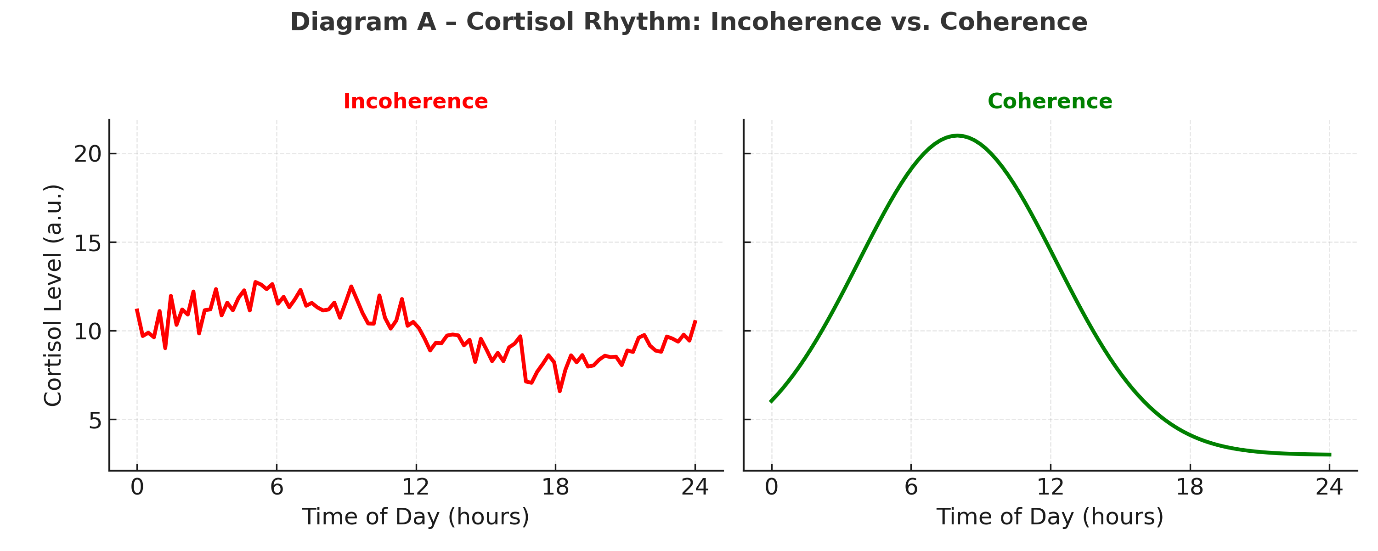
In incoherence, cortisol rhythms flatten or spike at inappropriate times, leaving individuals “tired but wired.” In coherence, the diurnal slope restores: a healthy morning rise, graceful decline through the day, and quiet nights that allow deep rest and repair.
Clinical parallels:
- Research on mindfulness, meditation, and restorative practices consistently shows steeper diurnal cortisol slopes (a sign of recovery and coherence).
- Field observations confirm this: in coherent individuals, even under external stress, cortisol rhythms stay anchored, with less “spillover” into the night.
Our addition:
Coherence is not simply stress reduction; it is stress precision. The HPA axis learns to discriminate real signals from noise. Awareness aligned with the field acts as a filter, preventing false alarms from consuming biological energy. Cortisol becomes rhythmic again — not by suppression, but by entrainment.
3. Thyroid & Metabolic Rhythm (HPT Axis)
The hypothalamic–pituitary–thyroid (HPT) axis regulates the tempo of metabolism. Thyroid hormones (T3, T4) set the “metabolic clock,” governing how quickly cells convert nutrients and oxygen into usable energy.
- In incoherence:
o The thyroid often mirrors the instability of the stress system.
o Chronic threat signalling suppresses thyroid-releasing hormone (TRH) and thyroid- stimulating hormone (TSH), leading to subclinical hypothyroidism (sluggish energy, cold extremities, slowed digestion).
o In other cases, sympathetic dominance pushes hyperthyroid-like states — anxiety, weight loss despite hunger, palpitations.
o Subjectively, incoherence is often felt as metabolic unpredictability: days of heavy fatigue alternating with restless overdrive.
- In coherence:
o The HPT axis stabilises. Thyroid hormones are released in steady rhythms, matching the body’s true energy needs.
o Energy use becomes adaptive rather than defensive — fuelling repair and creativity instead of constant vigilance.
o Thermoregulation improves: extremities warm, basal metabolic rate stabilises, and temperature variability decreases.
o Field observation: individuals often describe feeling “warm without overheating,” “light but grounded,” or “steady through the day without crashes.”
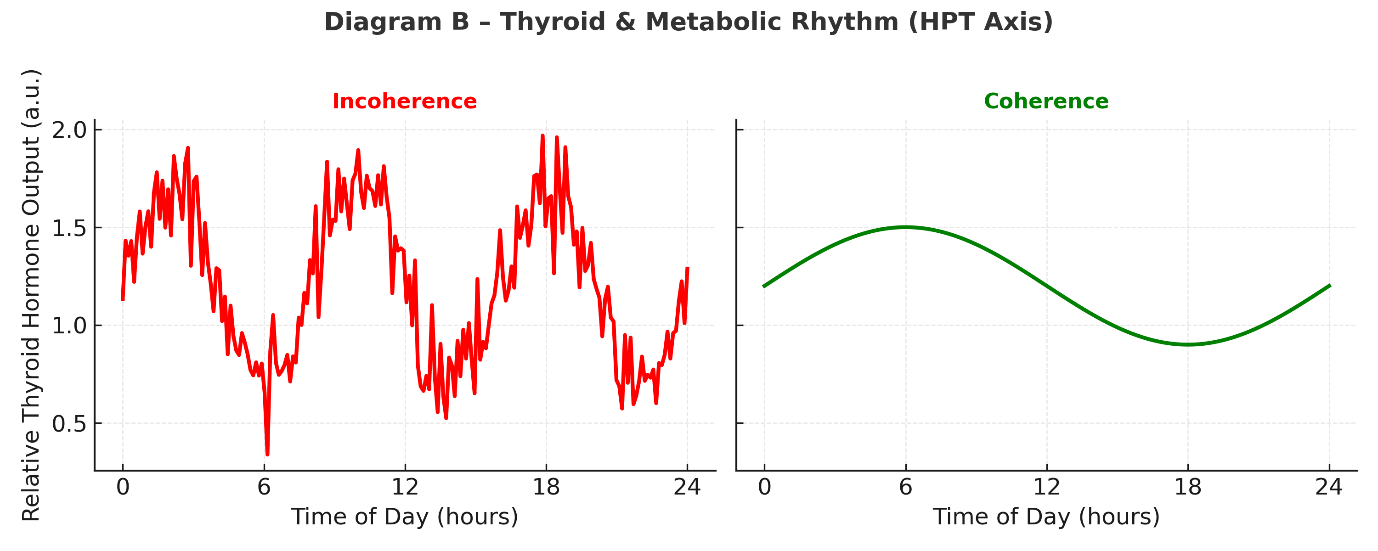
In incoherence, thyroid signalling becomes unstable — oscillating between sluggishness and hyperactivity, leading to fatigue, cold extremities, or restless overdrive. In coherence, thyroid rhythms stabilise, fuelling steady metabolism and thermoregulation in alignment with true energy needs.
Clinical parallels:
- Practices that induce coherence (slow breath, non-directive stillness, field alignment) are associated with improved thyroid markers in stress-related hypothyroidism.
- Studies show links between reduced cortisol load and improved TSH/T3 balance.
Our addition:
Stable awareness appears to provide the contextual intelligence that endocrine signalling lacks in isolation. In coherence, thyroid rhythm is not simply “faster” or “slower” — it is truer, matched to
circumstance. The HPT axis remembers its original design as a regulator of relational energy flow, not merely caloric throughput.
4. Reproductive Hormones (HPG Axis)
The hypothalamic–pituitary–gonadal (HPG) axis governs fertility, sexual cycles, and reproductive vitality. Its hormones — gonadotropins, estrogen, progesterone, testosterone — extend beyond reproduction to influence mood, bone health, muscle strength, and relational drive.
- In incoherence:
o Chronic stress and incoherent awareness suppress the HPG axis.
o Women: irregular or absent cycles, premenstrual symptoms amplified, fertility struggles.
o Men: lowered testosterone, reduced libido, diminished vitality.
o Across sexes: relational disconnection, emotional flatness, or compulsive patterns replacing genuine intimacy.
o The body interprets “unsafe field” as a signal that reproduction should be delayed.
- In coherence:
o The HPG axis reawakens and stabilises. Cycles become more regular, ovulation more reliable, fertility markers improve.
o In men, testosterone balances — not exaggerated, but steady, supporting energy, clarity, and relational presence.
o Libido re-aligns: not compulsive, but naturally woven into connection and play.
o Field observation: coherence often brings a subtle glow — skin clears, eyes brighten, posture opens, attraction softens into warmth.
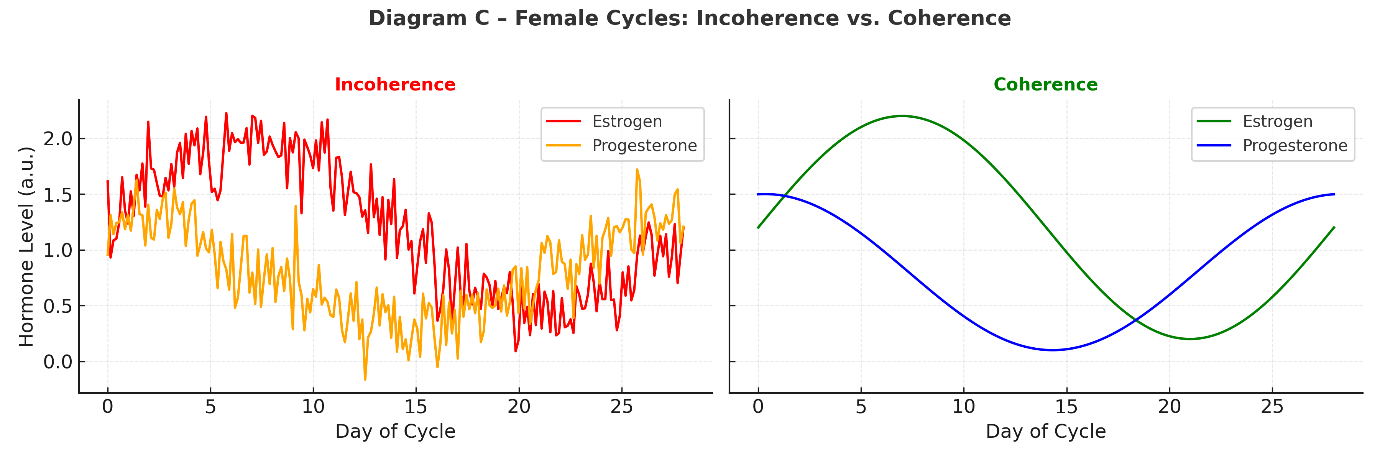
In incoherence, reproductive hormones fluctuate irregularly, cycles fragment, and fertility weakens. In coherence, estrogen and progesterone rise and fall in rhythmic synchrony, restoring stable cycles, fertility, and vitality.
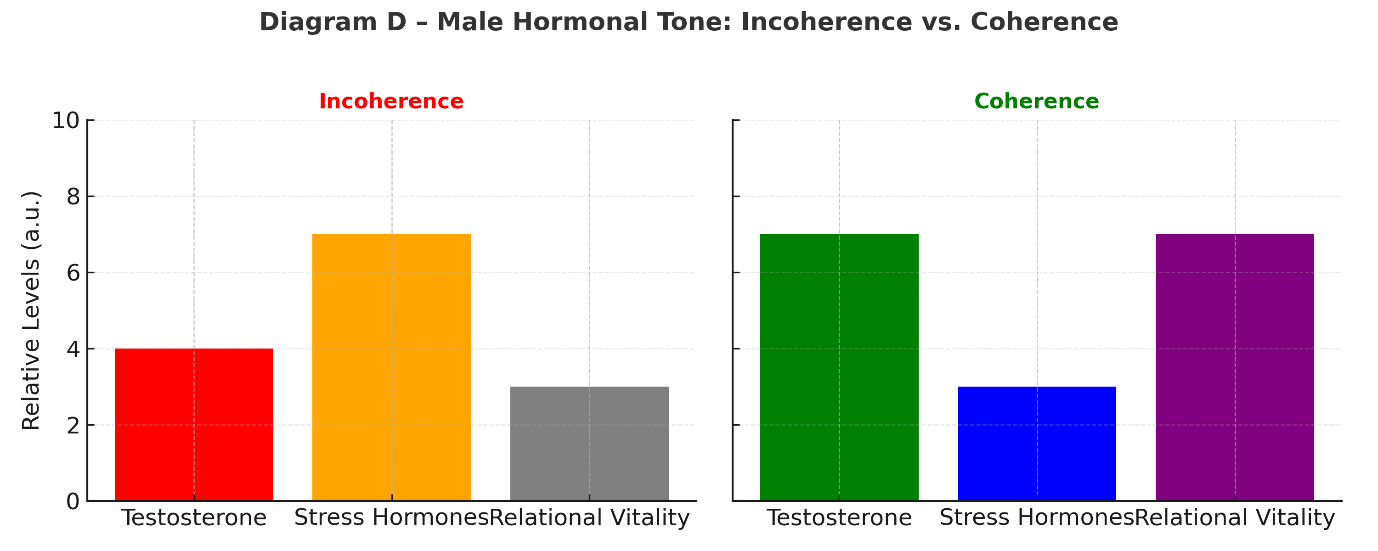
In incoherence, testosterone falls while stress hormones rise, leaving vitality and relational presence diminished. In coherence, testosterone balances, stress hormones quieten, and relational vitality strengthens.
Clinical parallels:
- Studies confirm stress as a leading driver of infertility and cycle disruption. Relaxation and safety cues restore reproductive signalling.
- Field alignment adds a layer: coherence does not just remove inhibition, it amplifies fertility tone — the body recognises safety as invitation, not absence of threat alone.
Our addition:
Reproduction is not only biological but field-relational. Stable awareness signals to the organism: the environment is coherent, resources are sufficient, connection is possible. The HPG axis responds by opening the pathways of generativity — both literal (fertility) and symbolic (creativity, new projects, relational renewal).
5. Oxytocin, Vasopressin, and Relational Tone
Beyond survival and reproduction, the endocrine system holds a deeper purpose: connection.
Two neuropeptides in particular — oxytocin and vasopressin — regulate the bonds of trust, attachment, and social stability.
- In incoherence:
o Oxytocin release is blunted; individuals feel isolated, mistrustful, and withdrawn.
o Vasopressin, often linked to vigilance and territorial behaviour, becomes dominant, leading to defensiveness, jealousy, and social friction.
o Relationships fracture under the weight of threat perception: others are seen as competitors or dangers rather than allies.
- In coherence:
o Oxytocin levels rise steadily, supporting trust, compassion, and prosocial behaviour.
o Vasopressin is no longer distorted into defensiveness; instead, it supports healthy boundaries and commitment.
o Relational tone shifts: less conflict, more presence, deeper intimacy.
o Field observation: coherent individuals often report “effortless kindness,” “safety in silence,” or “ease in closeness without fear.”
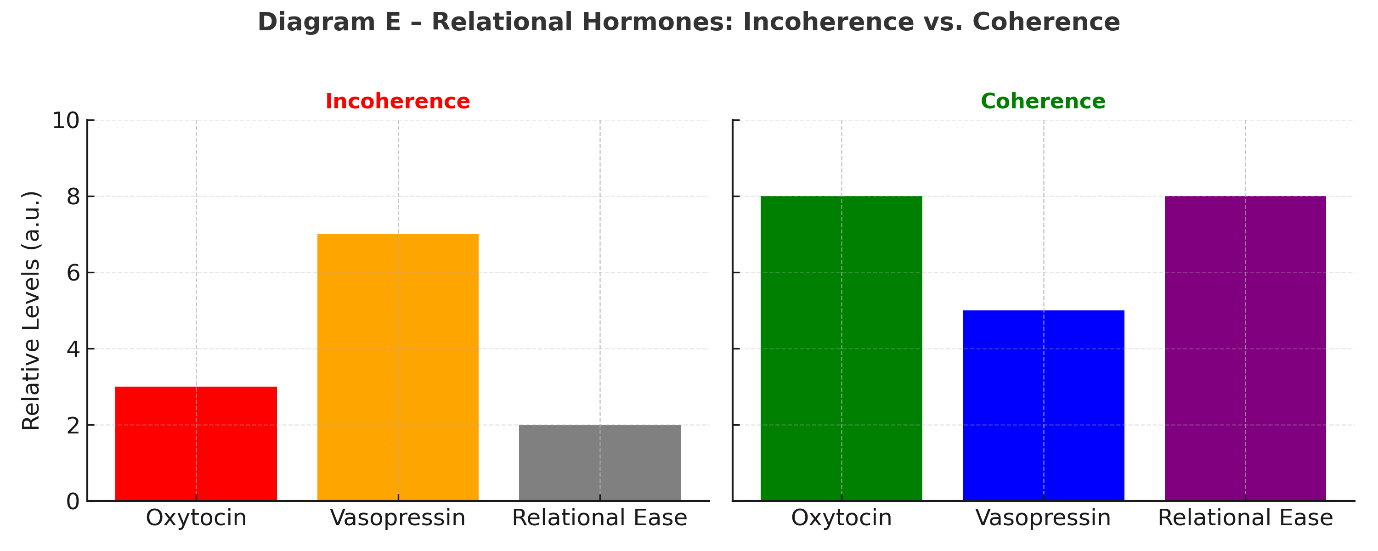
In incoherence, oxytocin falls and vasopressin dominates, creating mistrust and defensive vigilance. In coherence, oxytocin rises, vasopressin balances, and relational ease emerges — trust and connection become the default tone.
Clinical parallels:
- Research links oxytocin to reduced stress reactivity, increased empathy, and improved healing outcomes.
- Coherence practices correlate with enhanced vagal tone, which is known to stimulate oxytocin pathways.
- Animal studies show social bonding hormones flourish in predictable, safe environments — coherence appears to provide the human analogue of such safety.
Our addition:
Coherence provides the field of safety in which oxytocin becomes the default and vasopressin the steady boundary. In this state, relationships reorganise around resonance rather than fear. This is not sentimentality — it is endocrine truth: trust is measurable, and coherence is its hidden regulator.
6. Melatonin, DHEA, and Longevity Hormones
The rhythms of sleep, repair, and aging are written in the hormones that mark biological time. Among the most important are melatonin (the sleep–darkness hormone) and DHEA (a broad- spectrum “youth” hormone supporting repair, immunity, and vitality).
- In incoherence:
o Melatonin release is blunted by late-evening cortisol and restless predictive processing.
o Sleep is shallow; deep (slow-wave) phases are shortened, leaving repair incomplete.
o DHEA levels decline prematurely, tilting the balance toward catabolism, immune weakening, and accelerated aging.
o Subjectively: individuals feel “never fully restored,” waking tired, aging faster than their years.
- In coherence:
o Cortisol quiets in the evening, allowing melatonin to rise naturally. Sleep deepens, dream cycles stabilise, and cellular repair accelerates.
o DHEA levels remain higher and more stable, buffering against the erosive effects of stress hormones.
o This balance — low nocturnal cortisol, high melatonin, steady DHEA — is a biomarker of biological youthfulness.
o Field observation: coherent individuals often show rapid recovery from exertion, brighter eyes, smoother skin, and a sense of “time slowing down.”
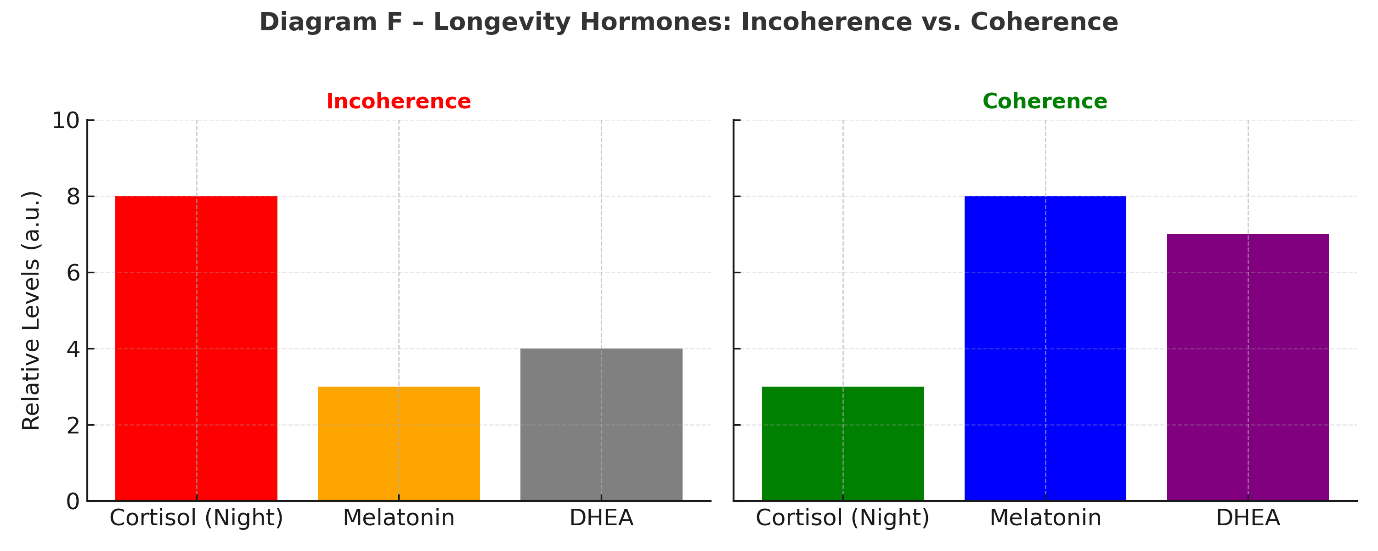
In incoherence, nocturnal cortisol remains high while melatonin and DHEA decline, weakening repair and accelerating aging. In coherence, cortisol quiets at night, melatonin rises, and DHEA stabilises — restoring repair, vitality, and biological youthfulness.
Clinical parallels:
- Studies show meditation and coherence practices increase nocturnal melatonin secretion and preserve DHEA levels.
- Longitudinal data link steep cortisol slopes, high DHEA, and melatonin rhythm to longer healthspan.
Our addition:
Coherence appears to retune the circadian clock. The body begins to live not on artificial cycles of stress and exhaustion, but on the quiet rhythm of light and dark, breath and stillness. In this, longevity is not achieved by fighting aging, but by remembering youthfulness as the body’s natural state in coherence with the field.
7. Mechanistic Hypothesis: Endocrine Orchestration in Coherence
The endocrine system is often studied in fragments — the HPA (stress), HPT (metabolism), HPG (reproduction), pineal (sleep), adrenal (vitality), and hypothalamic neuropeptides (bonding). Yet in lived experience, these are not separate axes. They are instruments in a symphony.
- In incoherence:
o Each axis plays out of rhythm.
o The HPA drowns out subtler instruments with constant threat signalling.
o The HPT swings between sluggish and hyperactive.
o The HPG retreats, withholding fertility.
o Oxytocin fades, vasopressin distorts.
o Melatonin and DHEA decline, aging accelerates.
o The system as a whole becomes noisy, inefficient, and costly.
- In coherence:
o Awareness acts as the conductor.
o The HPA learns precision: only striking when truly needed, then quieting again.
o The HPT restores metabolic rhythm, fuelling life rather than defence.
o The HPG opens fertility and creative generativity.
o Oxytocin rises, relational bonds deepen, trust stabilises.
o Melatonin and DHEA re-establish their youthful balance, slowing biological wear.
o Together, the orchestra produces hormonal harmony: rhythms align, costs decrease, life becomes symphonic.
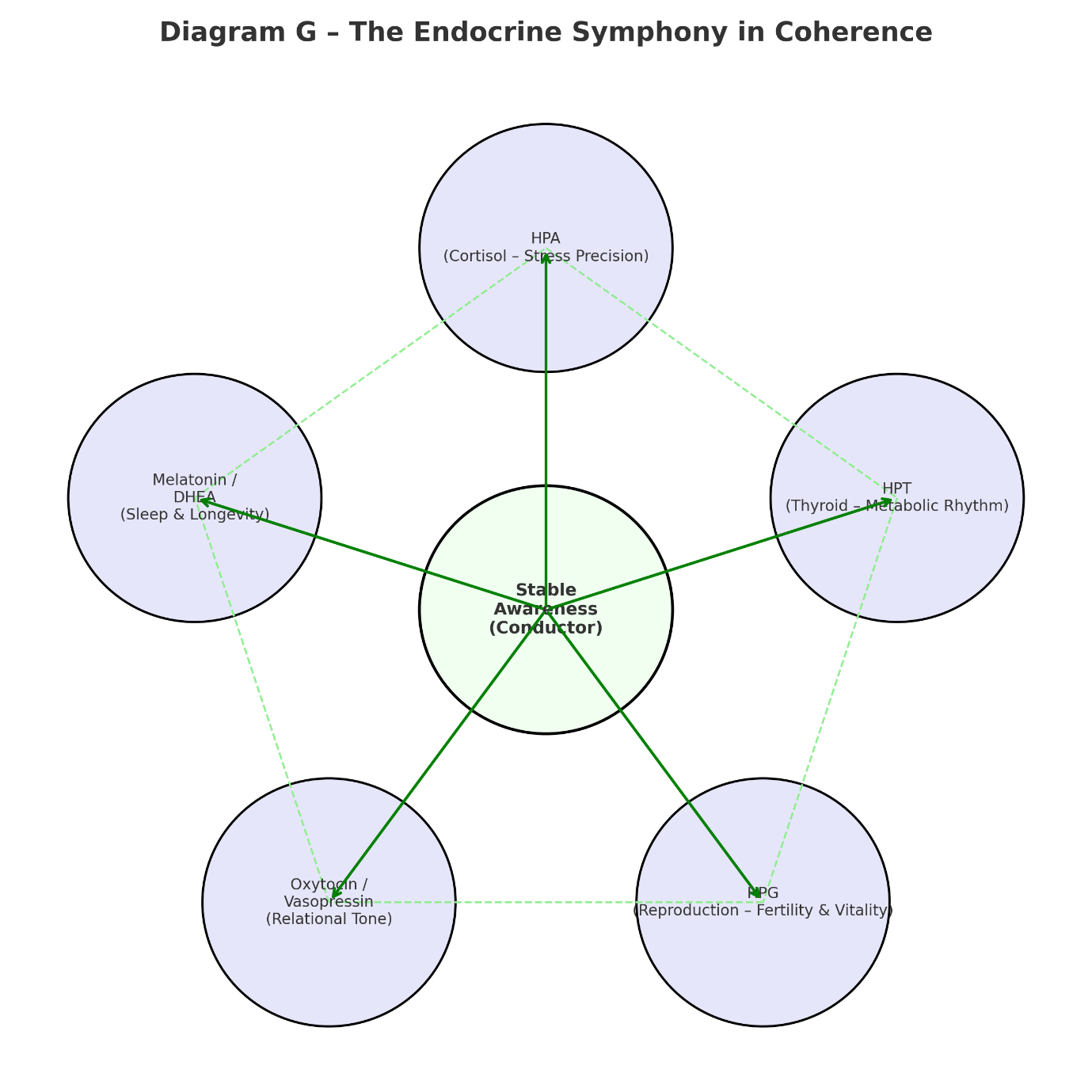
In incoherence, endocrine axes scatter into noise — stress dominates, metabolism falters, fertility withdraws, connection breaks, and repair weakens. In coherence, stable awareness acts as the conductor: aligning HPA, HPT, HPG, social peptides, and longevity hormones into one rhythmic symphony.
Mechanistic frame:
Stable awareness reduces false prediction errors → lowers unnecessary stress signalling → restores circadian and reproductive rhythms → elevates social bonding peptides → preserves repair hormones. The endocrine system shifts from survival triage to regenerative flow.
Our addition:
This orchestration is not imposed from outside. It emerges when interference is removed. Coherence itself is the organising attractor, a field-state that synchronises the endocrine system into harmony. Hormones, long seen as merely chemical messengers, reveal themselves as rhythmic instruments of relational coherence.
8. Implications
Medicine
- Coherence offers an adjunctive path for conditions rooted in endocrine dysregulation — stress disorders, thyroid imbalance, infertility, burnout, insomnia, and accelerated aging.
- Rather than forcing hormone levels with pharmaceuticals, coherence reframes healing as the restoration of rhythm and synchrony.
- This suggests a low-cost, non-invasive complement to conventional care.
Performance
- Hormonal coherence enhances recovery, muscle repair, and stable energy availability.
- Athletes and performers in coherent states report quicker adaptation to training loads, steadier mood, and improved relational dynamics in team settings.
Longevity
- Preservation of DHEA and melatonin, together with reduced cortisol burden, aligns with extended healthspan.
- Coherence suggests a path to “youthfulness remembered” — not through external anti- aging interventions, but through natural re-harmonisation of internal clocks.
Society
- At scale, coherence-based endocrine stability could reduce healthcare burden, improve fertility outcomes, enhance social trust, and re-anchor collective rhythms.
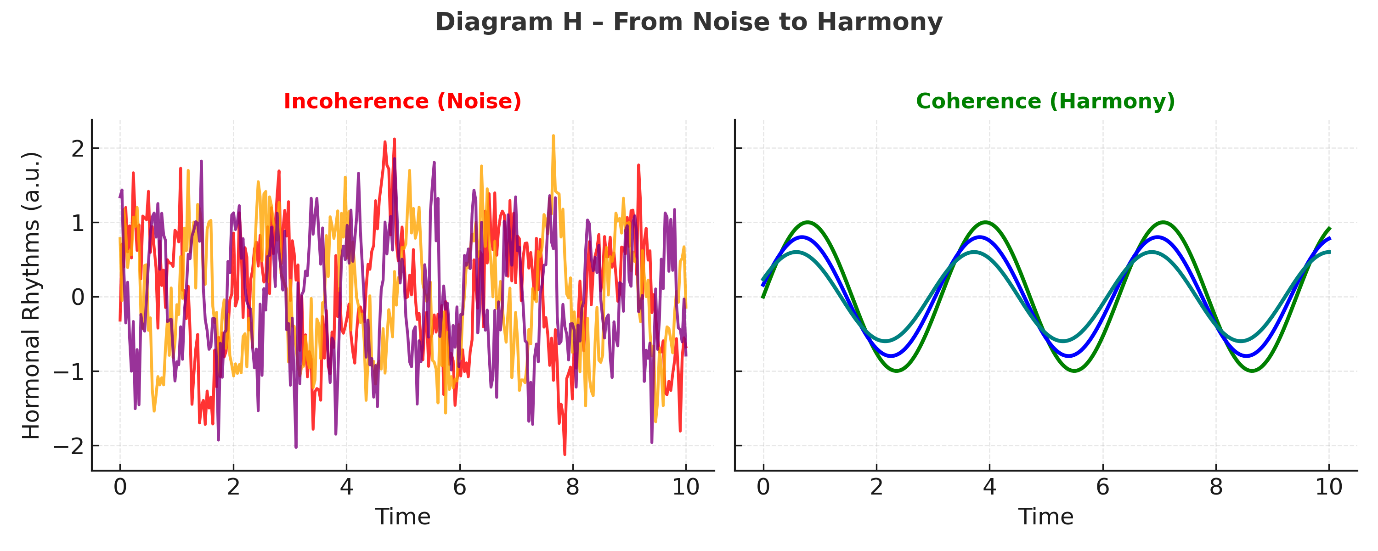
In incoherence, endocrine rhythms scatter into noise, consuming energy and fragmenting vitality. In coherence, rhythms align into harmony — the body’s signals converge into synchrony, lowering cost and amplifying flow.
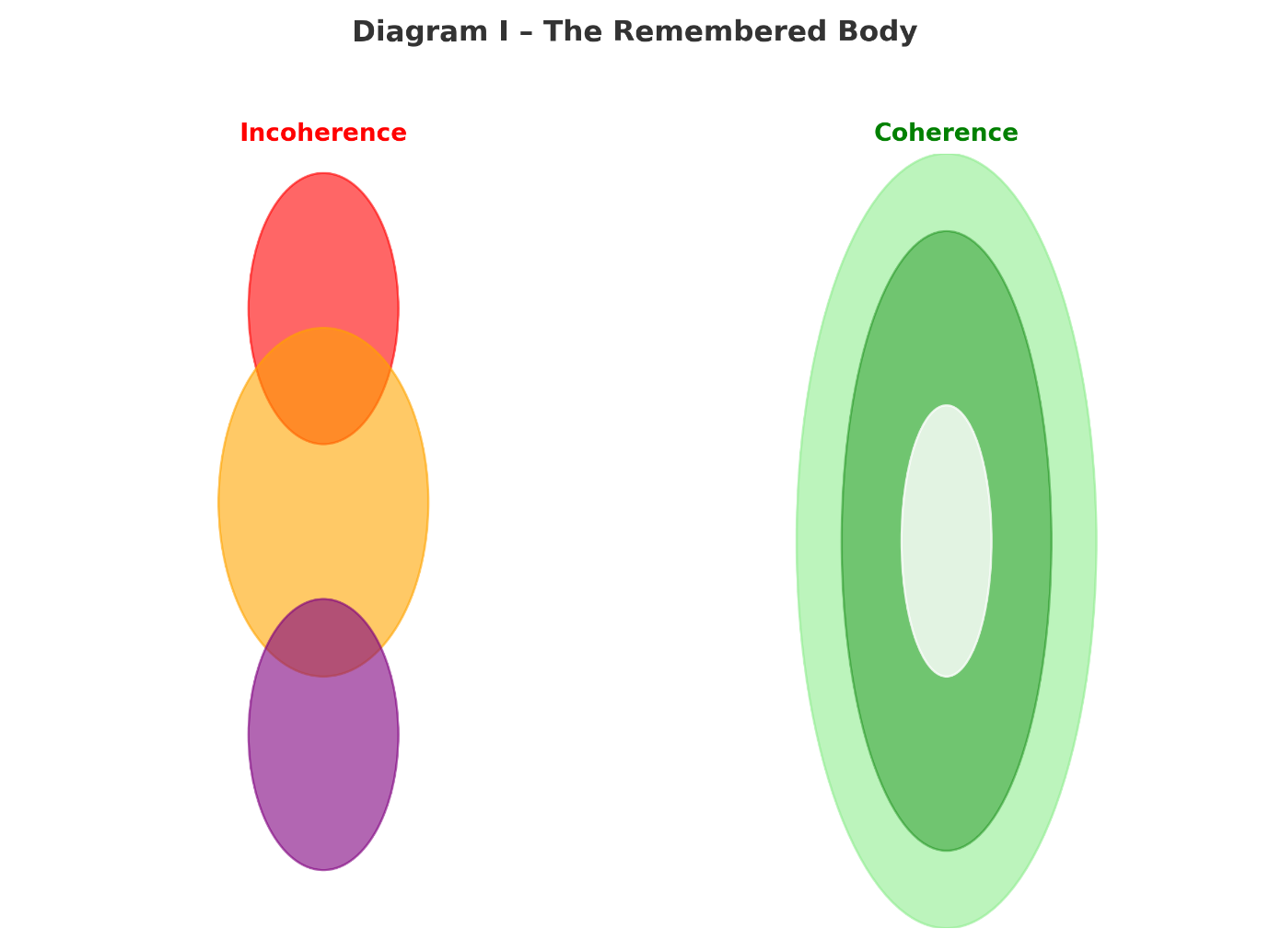
In incoherence, the body fragments under stress, its systems pulling in competing directions. In coherence, the body remembers its original design: unified, radiant, and efficient — a physiology aligned with the field.
9. Conclusion
Hormones are not merely chemical messengers — they are rhythmic carriers of coherence.
When awareness is fragmented, the endocrine system scatters, caught in loops of defence and depletion. When awareness is stable, the endocrine orchestra finds its conductor: rhythms align, energy is used wisely, fertility opens, sleep deepens, and bonds strengthen.
This is not abstract philosophy but physiological truth: coherence is measurable in cortisol slopes, thyroid steadiness, ovulatory regularity, oxytocin levels, melatonin peaks.
The endocrine system reveals coherence as both mechanism and marker.
To live in coherence is to remember that the body is not at war with itself.
It is a symphony waiting for its conductor.
Stable awareness is that conductor.
And when it steps onto the stage, the body remembers its song.